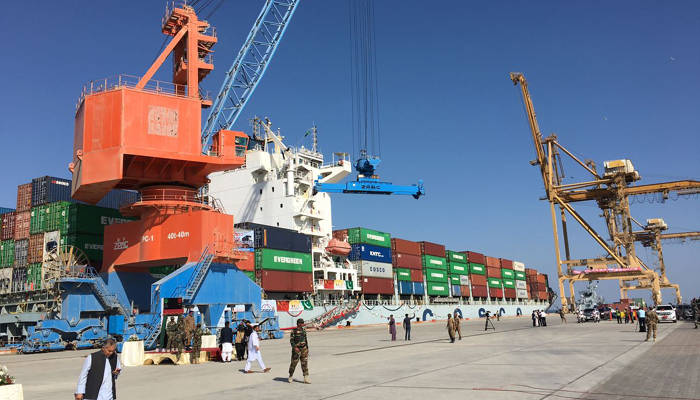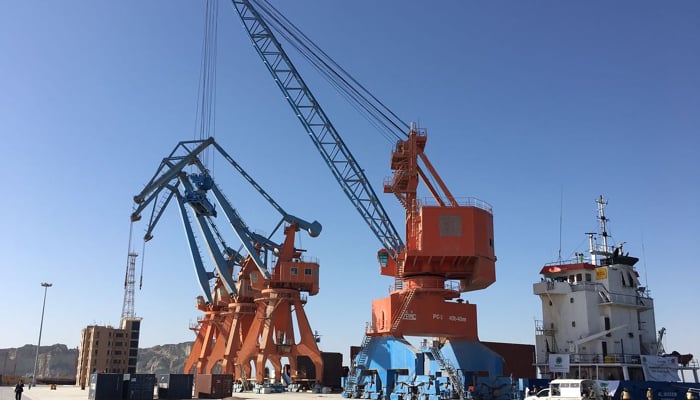Zain Malik
FULL MEMBER

- Joined
- Oct 13, 2015
- Messages
- 1,511
- Reaction score
- 3
- Country
- Location
Hello Guys I came up with my article on CPEC as I was really interested in this whole project of Infrastructure and development in Pakistan. SI I decided to write a complete information article on it which I will post here in 3 steps one-by-one As I will write so Most of the information you will find here related to CPEC and dont have to click google every time you need to know something about CPEC.
Its my request to @mods Not to merge this thread with the already existing CPEC threads because there will be no general discussion here Just if someone has information or latest news about CPEC post it here.
So lets get started PART 1/3:
Introduction
CPEC, China Pakistan Economic Corridor first announced in 2013, but finalized during Mr. Xi Jinping’s official visit to Pakistan in April 2016. This project is considered as a crucial module of OBOR, One Belt One Road. OBOR design is considered as a central point of Chinese Foreign Policy. CPEC is herald truly a game changer in geo-politics specifically for this region. This copious project consists of massive investment in Pakistan’s system of telecommunication, energy, infrastructure of transport which eventually extended from Southwestern Gwadar Port of Pakistan to the Kashgar City of China Xinjiang Province and many more, worth of U.S $46 billion[1].

The Project
This project is commonly known as “New Silk Road (One Road)” which will run through the Central South Asia, aimed to make efforts in the creation of “Maritime Silk Road (One Belt)” in the Indian Ocean. The two routes will be linked through Pakistani port city of Gwadar. After the completion, CPEC will establish a new network of roads, gas pipelines, railways and energy worth of billions dollars. Funding by Chinese government, there was a company established named The Silk Road Fund Company in December last, this project promotes industrial collaboration with Pakistan. There will be a pioneering project which has to be implemented under the CPEC is Karot Hydropower Project of 720 MW, 1.65 billion US Dollars has been allocated from Silk Road Fund. Furthermore, there will be 33.79 billion US Dollars for overall energy projects, 5.9 billion US Dollars for roads, 3.69 billion US Dollars for railway networks and 66 and 4 Million US Dollars for Gwadar Port and Fiber Optic project respectively[2]. In addition, there will be many short term projects also involved in this project such as:
- 1681 Kilometer Karachi – Lahore – Peshawar Railway Lines Up gradation
- Coal Power Plants 1980 MV in Thar, Singh Province
- Gwadar – Nawabshah Natural Gas Pipeline
- 1320 MV Coal based power plants at Bin Qasim Port
- Solar Park 900 MV in Bahawalpur
- Havelian-Islamabad Karakoram Highway Link
- 260 MW Jhimpir Wind Farm
- Gwadar International Airport
Geostrategic Significances of CPEC
The significance of CPEC is intensified by former Sino-Pakistani treaty (the renowned Sino-Pakistani Boundary Agreement 2nd March, 1963) according which Pakistan has to be granted 40 years full operational control of Gwadar Port, situated on the heart of Indian Ocean and deliberately very close to the Strait of Hormuz, which is considered the mouth of Persian Gulf. China will surely enable to monitor its communication lines, specifically its sixty percent West Asian crude oil imports. Fully operational Gwadar port ensures the security of its lion share oil requirements with costs billions of dollars. Similarly, but more importantly this new route would avoid Strait of Malacca and it considered more significant regarding the growing presence of the United States in South China Sea. It will also weaken the strategic significance of the United States’ Navy, while keep eyes on US naval activities, all this will happen almost 460 kilometers West of Karachi Port but having safe remoteness from Indian Navy bases. Furthermore, after the operational completion of Gwadar port, Chinese Navy can easily take military facilities in the region, so as a relevant factor Pakistan initiate in the purchase of diesel powered attack submarines. This entire scenario will surely boost the level of confidence of Pakistan Navy; especially the submarine fleet could possible counter those attempts which can make by Indian Navy to obstruction of Pakistani Ports on Indian Ocean[3].
[1] www.abc.net.au/news/china-president-visits-middle-east-inks-deals-worth-billions/7106292
[2] Engr Hussain Ahmad Siddiqui’s Article CPEC Projects – Status, Cost and Benefits – Published in Dawn, Economics and Business 13th July, 201
[3] Xu, S. (2015) ‘Vision and Actions on Jointly Building Silk Road Economic Belt and 21st-Century Maritime Silk Road’, National Development and Reform Commission, Ministry of Foreign Affairs, and Ministry of Commerce of the People's Republic of China, with State Council authorization, (2015)
@Kaptaan @The Eagle @WAJsal @Manticore @GreenFalcon @war&peace @Moonlight @The Sandman @Zibago @django @Arsalan @Aether @Emmie @Spring Onion @Basel @Tipu7 @dsr478 @HAKIKAT @Hiraa @Chauvinist @MarvellousThunder@PDC @Chinese-Dragon @ChineseTiger1986 @PARIKRAMA @New World @ACE OF THE AIR @Windjammer @YousufSSG @Airdef95 @BondedByBlood @Morse_Code @Talha Asif @Mentee @KediKesenFare @HRK @BDforever @T-123456 @B+ Dracula @EAK @Muhammad Omar @NoamMaalik @Tripoli @PaklovesTurkiye @Syed Asif Bukhari @ghauri05 @MastanKhan @Hamartia Antidote @long_ @Beast @Two @wanglaokan @beijingwalker @lonelyman @PakSword @WebMaster @Horus @maximuswarrior @Khafee @TheGreatOne @My-Analogous @Oscar
@Zhu Rong Zheng Yang @Fawad Masīd @Side-Winder @Zarvan @Devil Soul @DESERT FIGHTER @Doordie @AndrewJin @Icarus @Imran Khan
Your Input will be valuable for me.
Its my request to @mods Not to merge this thread with the already existing CPEC threads because there will be no general discussion here Just if someone has information or latest news about CPEC post it here.
So lets get started PART 1/3:
Introduction
CPEC, China Pakistan Economic Corridor first announced in 2013, but finalized during Mr. Xi Jinping’s official visit to Pakistan in April 2016. This project is considered as a crucial module of OBOR, One Belt One Road. OBOR design is considered as a central point of Chinese Foreign Policy. CPEC is herald truly a game changer in geo-politics specifically for this region. This copious project consists of massive investment in Pakistan’s system of telecommunication, energy, infrastructure of transport which eventually extended from Southwestern Gwadar Port of Pakistan to the Kashgar City of China Xinjiang Province and many more, worth of U.S $46 billion[1].
The Project
This project is commonly known as “New Silk Road (One Road)” which will run through the Central South Asia, aimed to make efforts in the creation of “Maritime Silk Road (One Belt)” in the Indian Ocean. The two routes will be linked through Pakistani port city of Gwadar. After the completion, CPEC will establish a new network of roads, gas pipelines, railways and energy worth of billions dollars. Funding by Chinese government, there was a company established named The Silk Road Fund Company in December last, this project promotes industrial collaboration with Pakistan. There will be a pioneering project which has to be implemented under the CPEC is Karot Hydropower Project of 720 MW, 1.65 billion US Dollars has been allocated from Silk Road Fund. Furthermore, there will be 33.79 billion US Dollars for overall energy projects, 5.9 billion US Dollars for roads, 3.69 billion US Dollars for railway networks and 66 and 4 Million US Dollars for Gwadar Port and Fiber Optic project respectively[2]. In addition, there will be many short term projects also involved in this project such as:
- 1681 Kilometer Karachi – Lahore – Peshawar Railway Lines Up gradation
- Coal Power Plants 1980 MV in Thar, Singh Province
- Gwadar – Nawabshah Natural Gas Pipeline
- 1320 MV Coal based power plants at Bin Qasim Port
- Solar Park 900 MV in Bahawalpur
- Havelian-Islamabad Karakoram Highway Link
- 260 MW Jhimpir Wind Farm
- Gwadar International Airport
Geostrategic Significances of CPEC
The significance of CPEC is intensified by former Sino-Pakistani treaty (the renowned Sino-Pakistani Boundary Agreement 2nd March, 1963) according which Pakistan has to be granted 40 years full operational control of Gwadar Port, situated on the heart of Indian Ocean and deliberately very close to the Strait of Hormuz, which is considered the mouth of Persian Gulf. China will surely enable to monitor its communication lines, specifically its sixty percent West Asian crude oil imports. Fully operational Gwadar port ensures the security of its lion share oil requirements with costs billions of dollars. Similarly, but more importantly this new route would avoid Strait of Malacca and it considered more significant regarding the growing presence of the United States in South China Sea. It will also weaken the strategic significance of the United States’ Navy, while keep eyes on US naval activities, all this will happen almost 460 kilometers West of Karachi Port but having safe remoteness from Indian Navy bases. Furthermore, after the operational completion of Gwadar port, Chinese Navy can easily take military facilities in the region, so as a relevant factor Pakistan initiate in the purchase of diesel powered attack submarines. This entire scenario will surely boost the level of confidence of Pakistan Navy; especially the submarine fleet could possible counter those attempts which can make by Indian Navy to obstruction of Pakistani Ports on Indian Ocean[3].
[1] www.abc.net.au/news/china-president-visits-middle-east-inks-deals-worth-billions/7106292
[2] Engr Hussain Ahmad Siddiqui’s Article CPEC Projects – Status, Cost and Benefits – Published in Dawn, Economics and Business 13th July, 201
[3] Xu, S. (2015) ‘Vision and Actions on Jointly Building Silk Road Economic Belt and 21st-Century Maritime Silk Road’, National Development and Reform Commission, Ministry of Foreign Affairs, and Ministry of Commerce of the People's Republic of China, with State Council authorization, (2015)
@Kaptaan @The Eagle @WAJsal @Manticore @GreenFalcon @war&peace @Moonlight @The Sandman @Zibago @django @Arsalan @Aether @Emmie @Spring Onion @Basel @Tipu7 @dsr478 @HAKIKAT @Hiraa @Chauvinist @MarvellousThunder@PDC @Chinese-Dragon @ChineseTiger1986 @PARIKRAMA @New World @ACE OF THE AIR @Windjammer @YousufSSG @Airdef95 @BondedByBlood @Morse_Code @Talha Asif @Mentee @KediKesenFare @HRK @BDforever @T-123456 @B+ Dracula @EAK @Muhammad Omar @NoamMaalik @Tripoli @PaklovesTurkiye @Syed Asif Bukhari @ghauri05 @MastanKhan @Hamartia Antidote @long_ @Beast @Two @wanglaokan @beijingwalker @lonelyman @PakSword @WebMaster @Horus @maximuswarrior @Khafee @TheGreatOne @My-Analogous @Oscar
@Zhu Rong Zheng Yang @Fawad Masīd @Side-Winder @Zarvan @Devil Soul @DESERT FIGHTER @Doordie @AndrewJin @Icarus @Imran Khan
Your Input will be valuable for me.
Last edited:






 For the nice write-up
For the nice write-up











